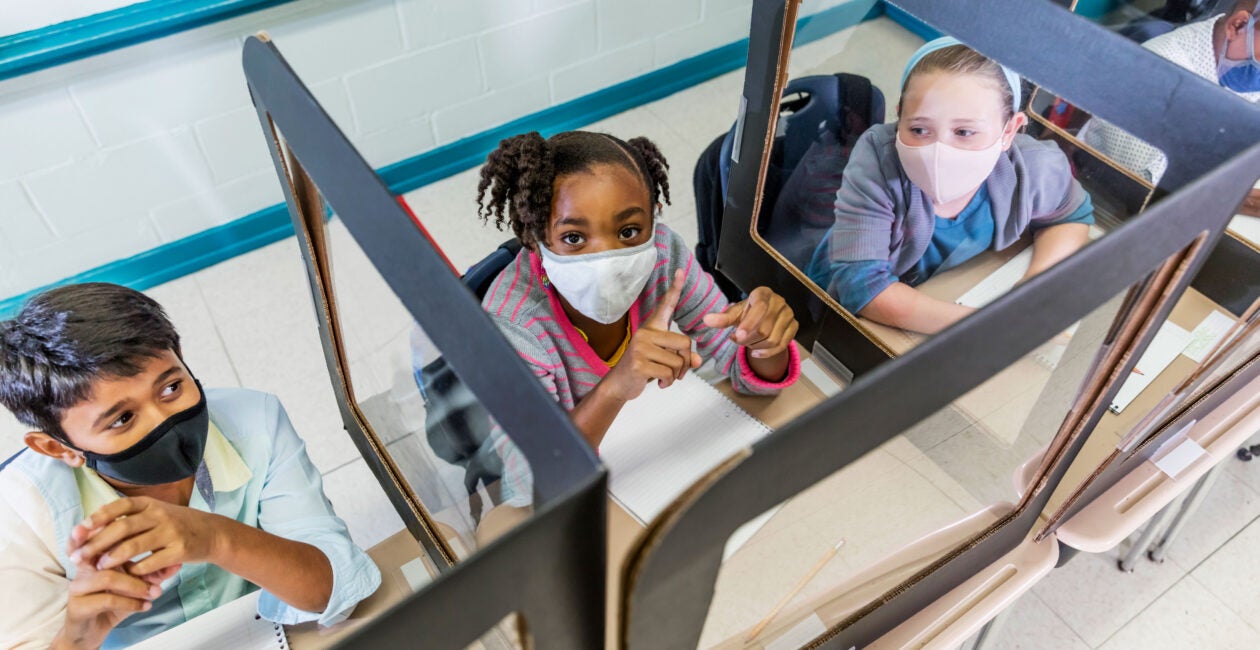COVID-19 itself has not been killing kids in droves.
According to figures cited by the American Academy of Pediatrics, among the 46 states that reported, “children were 0.00-0.26 percent of all COVID-19 deaths, and four states reported zero child deaths.”
But you’d never know that from the policies many states have instituted, including remote schooling, mask mandates, sitting 6 feet apart at lunch, and even quarantining from school.
The Daily Signal depends on the support of readers like you. Donate now
Despite being the lowest-risk demographic, in many ways, kids have carried the biggest burden, suffering learning loss, emotional and behavioral issues, and myriad other traumas that will be difficult, if not impossible, to undo.
We all know how adults are coping with the pandemic, but we’re grown-ups. We can handle it. The COVID-19 pandemic through the eyes of a child looks something like this: No school, no recess, no friends. Remote learning. Math on an app and English on a computer, sometimes without an adult nearby to help. Back to school. Desks 6 feet apart. Masks. No uncovered faces, no expressions. No physical cues to communicate. Increased anxiety. Washing hands. Wiping down desks. Substitute teachers. Worried parents. Missed assignments. Endless quarantines.
COVID-19 policies in liberal states are hurting kids even more than the disease is.
In Montgomery County, Maryland, a bastion of liberalism just outside of the nation’s capital, health officials say the county wants to implement a vaccine passport to increase vax rates among children 5-11 years old, despite no research available about the possible long-term effects of the shots.
If they don’t comply? They’re banned from living life. (Think dining out, concerts, etc.) The risk of getting COVID-19, much less dying from it, is minuscule, yet kids won’t be able to get out and be able to experience some of the small joys of life.
School is really where COVID-19 theater has robbed kids of a real life, and that’s key, because kids in K-12 spend a lot of time in school.
Some teachers are taking COVID-19 policies so far that kids live in fear of breaking the rules. A teacher in the North Penn School District—in another Montgomery County, this one in Pennsylvania—taped a young child’s mask to his face. New Jersey Gov. Phil Murphy just announced mask mandates for schools and day care facilities, despite the fact that there’s little evidence they’re effective, but plenty of evidence showing that children are at near-zero risk of dying from COVID-19.
One female student expressed exasperation with mask mandates at a Jan. 19 meeting of the Naperville School Board in Illinois:
Thank you for teaching students that our own mental health is much less important than making triple-vaccinated adults feel safe. … Thank you for not reaching out to the students to ask about how we feel about masks, because if you did, the majority of students would say that they hate masks, and then you might second-guess your decision to make us wear them.
Through the sarcasm, the contempt she has for the school board is obvious.
The Centers for Disease Control and Prevention actually recognized some of the issues with masks that conservatives and others have sought to address.
In September, the CDC changed its mask guidance and called for cloth masks with clear panels for children learning to read, among other cases related to speech and language development and special needs, but it was too little too late.
School administrators are stuck in their own ways—COVID-19 protocols from March 2020 play on an endless loop in their heads and influence their policies, however poorly.
One Canadian teacher wrote a post on former New York Times journalist Bari Weiss’ Substack website that should bring any person with an ounce of empathy to tears. In Canada, just 23 children have died over the past two-plus years, but it hasn’t stopped Canada’s schools from forcing kids to adapt to an awful way of life.
When we were physically in school, it felt like there was no longer life in the building. Maybe it was the masks that made it so no one wanted to engage in lessons, or even talk about how they spent their weekend. But it felt cold and soulless.
My students weren’t allowed to gather in the halls or chat between classes. They still aren’t. Sporting events, clubs, and graduation were all canceled.
These may sound like small things, but these losses were a huge deal to the students. These are rites of passages that can’t be made up.
In my classroom, the learning loss is noticeable. My students can’t concentrate, and they aren’t doing the work that I assign to them. They have way less motivation, compared to before the pandemic began.
Some of my students chose not to come back at all, either because of fear of the virus, or because they are debilitated by social anxiety. And now they have the option to do virtual schooling from home.
Learning loss among the youngest of schoolchildren, who have spent a third of their young lives navigating a pandemic, is difficult to calculate, but so far, it doesn’t look promising. One 2021 McKinsey & Co. study stated:
Our analysis shows that the impact of the pandemic on K–12 student learning was significant, leaving students on average five months behind in mathematics and four months behind in reading by the end of the school year.
Emotionally, older children especially are increasingly depressed. The suicide rate among teens has skyrocketed during the pandemic after they had their social lives ripped away as proms and graduation parties disappeared.
It’s true that kids are resilient. Some will recover from the emotional turmoil, the lost learning, and the trauma of constant rules and masks, but some won’t, but that’s not the point. We don’t force kids to endure trauma just because they have the capability of recovering.
We learned fairly early on that COVID-19 blessedly spared children and teens from death, yet we continued to act like the risk is great, proportional to the preventative measures we could take.
We thrust our collective anxieties on children and forced them to bear the burdens thereof at great cost. Now, we will watch as they try to pick themselves up, dust themselves off, and move on, because, in the final analysis, the risk of losing their lives for this was very small, and they still have a whole life to live.
The Daily Signal publishes a variety of perspectives. Nothing written here is to be construed as representing the views of The Heritage Foundation.
Have an opinion about this article? To sound off, please email letters@DailySignal.com and we’ll consider publishing your edited remarks in our regular “We Hear You” feature. Remember to include the url or headline of the article plus your name and town and/or state.





























